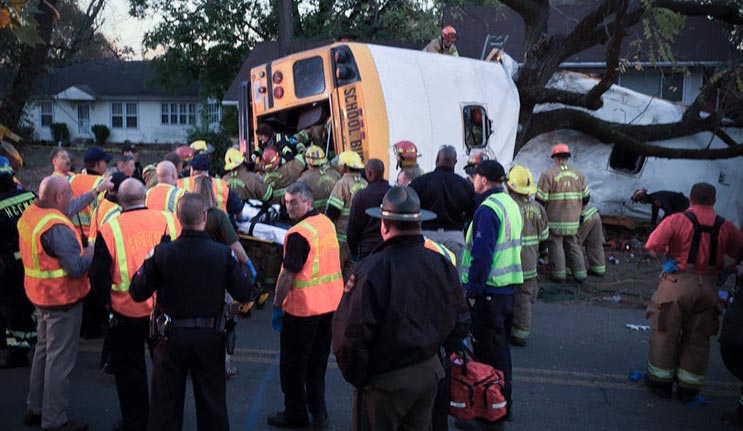With the devastating loss of six children in November’s Chattanooga school bus crash, school bus safety is the nation’s new topic. Unfortunately, it often takes tragedy to pursue much needed change.
And needed it is; while deadly crashes are rare, school bus accidents themselves aren’t. Dallas County School District in Texas reported a 103-percent increase in crashes, jumping from 200 in the 2014-15 school year to 405 the following. A second study discovered Florida school bus crashes increased 16 percent between 2012 and 2015, with one county jumping a startling 200 percent.
Despite all of this, school buses are statistically still the safest way for students to get to school. Their sheer size, height and weight make it hard for passenger cars to cause any serious damage; flashing lights, stop-sign arms and their recognizable color make them almost impossible to miss on the road; and protective seating and cross-view mirrors add an additional security layer. Not to mention, school buses keep an estimated 17 million cars off the road.
Crashes, injuries and fatalities persist, though. So who’s to blame?
As is true with all car crashes, each incident is unique. For every bus driver found at fault, a passenger car driver is also found in the wrong. Whenever drivers are behind a wheel-carrying 40 students or traveling solo through morning rush hour- it’s imperative to fight impatient urges and exercise extreme caution.
Know When to Stop
In short, passenger vehicles should always be prepared to use their brakes when driving near school buses. Yellow flashing lights are the universal symbol for a bus preparing to stop, while red flashing lights and an extended stop sign means stop. Unfortunately, “in short” doesn’t cut it anymore.
In general, when driving on a two-lane street or undivided roadways, all cars must stop. If a barrier separates the two directions, only cars traveling in the same direction must stop; however, all cars should proceed with caution as children can be unpredictable. While some states have stricter stop requirements than others, all 50 have severe penalties for violators from hefty fines to multiple points on licenses and even license suspension for repeat offenders. More importantly, however, obeying these basic laws can help save not only children’s lives, but your own.
Between 2004 and 2013, more than 1,000 people died in school-transportation related crashes, according to the National Highway Traffic Safety Administration (NHTSA). Seventy-one percent of fatalities were occupants of other cars while more than a third of students killed were struck by other vehicles sharing the road.
Still, it’s estimated thousands of cars illegally pass school buses on a daily basis, following an annual upward trend. This “expansion” of illegal passing is why boarding and deboarding school buses is the most dangerous time for bus riders, according to the Daytona Beach car accident attorneys of Bundza & Rodriguez, who led the aforementioned Florida study. The Florida Department of Education (FLDOE) backs them up, too. Each year the department asks willing bus drivers to tally the number of cars that illegally pass them on a pre-selected day. Less bus drivers participated in 2015 than in 2014, yet more incidents were reported.
All drivers should be aware of their specific state laws and remember school buses make frequent stops. Outside of pickup and dropoff locations, buses must also stop at all railroad crossings and in general, follow slower speed limits.
Remember the Passengers are Children
If adults don’t always look both ways when crossing the street, don’t expect children to. While it’s advised children arrive at bus stops five minutes early, all parents know this doesn’t always happen; look out for kids running across the street to make their bus. When backing out of driveways, double check for small children on sidewalks. Follow posted school-zone speed limits and always remain alert when driving during school time commutes.
Drive Defensively, Not Aggressively
Defensive driving is always safer than aggressive driving, but this is exponentially true when around school buses. With 26 million students riding the school bus every year, according to the American School Bus Council, it’s important to use caution when driving near such beloved cargo.
Rather than tailgating, anticipate frequent stops by driving at least 10 feet behind the bus. Rather than speeding up, allow buses to change lanes in front of you; preventing them from doing so could cause accidents with other drivers or force them off their required daily route. Finally, rather than cutting a bus off to make the exit, make decisions earlier or wait for the bus to pass. School buses, similar to trucks, require more time to break and may not fully stop in time when forced to act quickly.
Student fatalities from school bus accidents are rare, bus crashes themselves happen more often than most realize. Following simple safe-driving tactics such as stopping behind buses, remaining alert and driving defensively, could help prevent future tragedies.
 Jenna Murrell is a digital marketing specialist with Safer America, a consumer safety organization. Through data visualizations, interactive content and blogging, we’re working towards bringing safety into everyday conversations.
Jenna Murrell is a digital marketing specialist with Safer America, a consumer safety organization. Through data visualizations, interactive content and blogging, we’re working towards bringing safety into everyday conversations.

